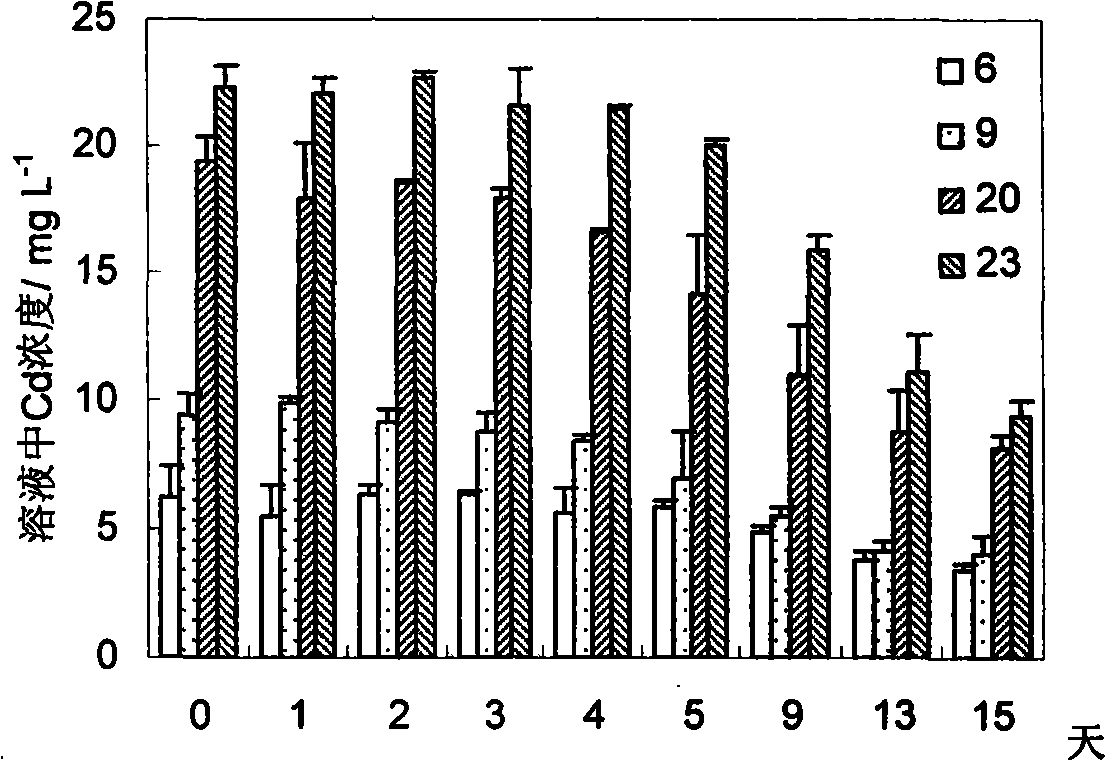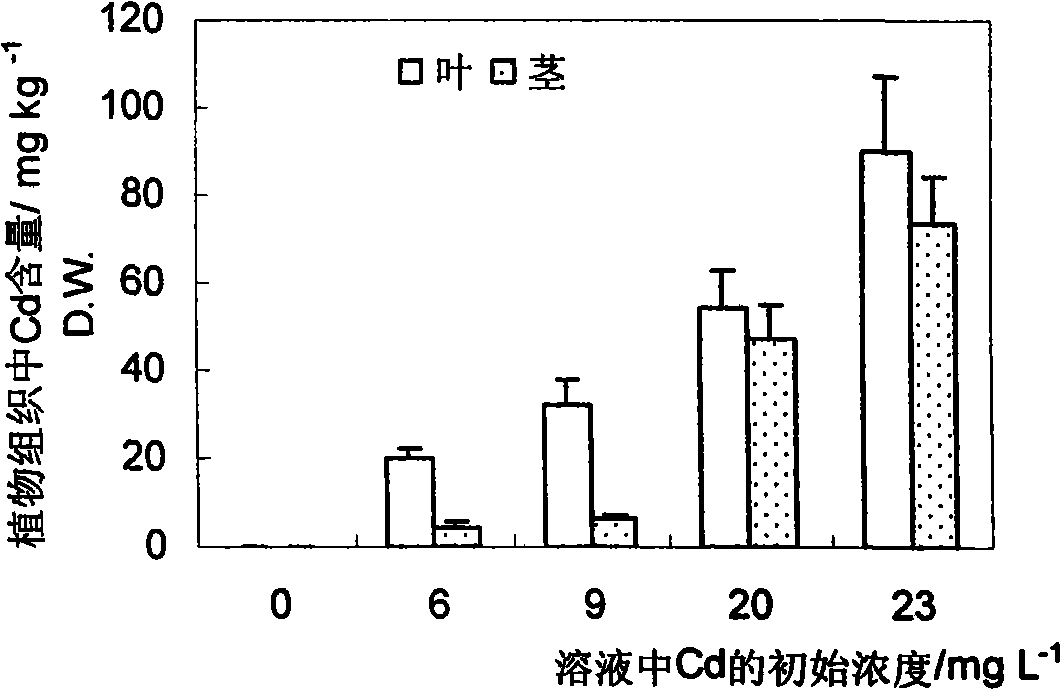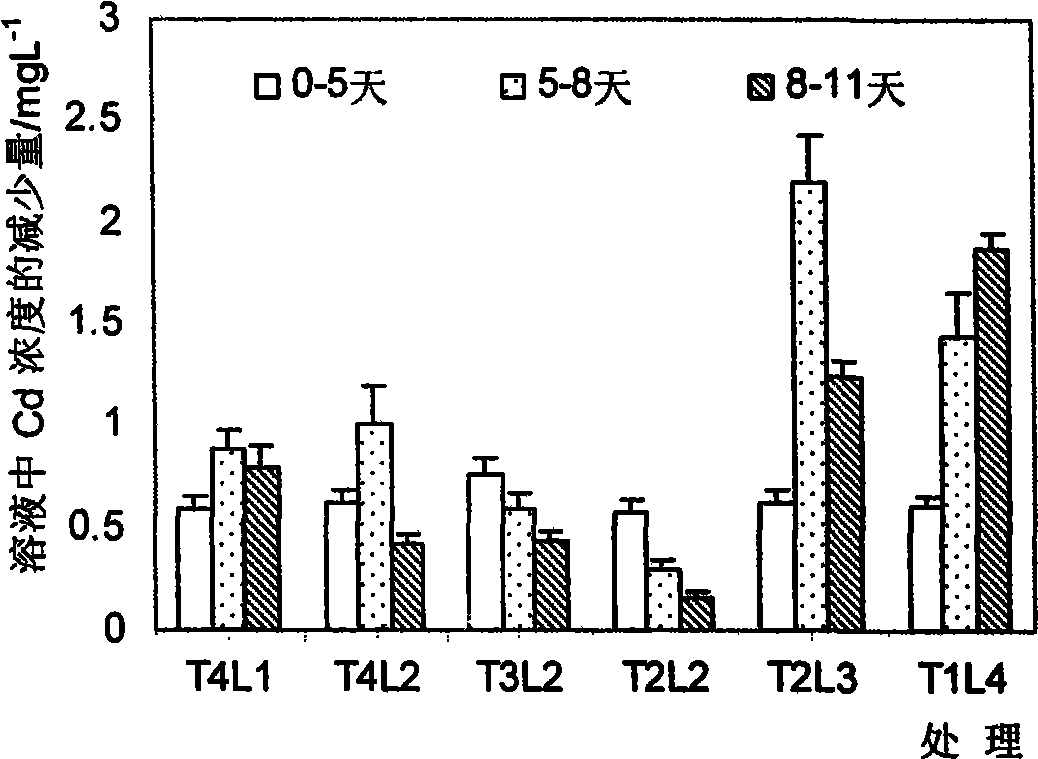Plant repairing method for soil polluted by heavy metal cadmium
A technology for cadmium-contaminated soil and phytoremediation, which is applied in the field of phytoremediation and chemical enhancement of heavy metal cadmium-contaminated soil, can solve the problems of unrealistic soil remediation and high production cost of EDDS reagents, and achieves improved remediation efficiency, low remediation cost, A wide range of effects
- Summary
- Abstract
- Description
- Claims
- Application Information
AI Technical Summary
Problems solved by technology
Method used
Image
Examples
Embodiment 1
[0025] Suliu clone J10ll (Salix×jiangsuensis CL.1011, referred to as Suliu J1011) was selected, and one-year-old seedlings were cut from the base of the seedlings in the nursery, brought back to the laboratory, and inserted into the culture medium for later use. The test cuttings were 15cm long and about 2cm in diameter. With 1 / 2 Hoagland nutrient solution as nutrition, with Cd(NO 3 ) 2 The solution is the mother solution, and the Cd concentration is set as follows: 0, 6, 9, 20 and 23 mg / L, a total of 5 treatments, and the test was carried out for 15 days, respectively, on days 1, 2, 3, 4, 5, 9, 13, and 15. Water samples were collected for determination, and plant samples were collected 15 days later to determine the Cd content in leaves and stems. Different concentrations of Cd in Suliu J1011 culture 2+ Cd in aqueous solution 2+ Concentration changes with time and different concentrations of Cd 2+ The content of Cd in the stems and leaves of Suliu J1011 after solution ex...
Embodiment 2
[0027] Effects of different ratios of EDTA and ethyl lactate on the enrichment of Cd in Suliu clone J10ll
[0028] Suliu clone J10ll (Salix×jiangsuensis CL.1011, referred to as Suliu J1011) was selected, and one-year-old seedlings were cut from the base of the seedlings in the nursery, brought back to the laboratory, and inserted into the culture medium for later use. The test cuttings were 15cm long and about 2cm in diameter. With 1 / 2 Hoagland nutrient solution as nutrition, with Cd(NO 3 ) 2The solution is the mother liquor, the mass concentration of Cd is set to 5mg / L, the molar ratio of the total amount of EDTA and ethyl lactate to Cd is 2:1, and the ratio of EDTA to ethyl lactate is set to 22:0, 22:5, 17 :5, 14:5, 14:8 and 11:11 (the total amount is counted as 22), respectively recorded as T4L1, T4L2, T3L2, T2L2, T2L3 and T1L4. For each of the above treatments, 3 replicates were set, and 4 cuttings were set for each replicate. A 1500mL plastic container was used for th...
Embodiment 3
[0031] In situ phytoremediation of heavy metal cadmium contaminated soil and its new chemical enhanced remediation effect
[0032] The restoration test site is located in a town in Jiangning District, Nanjing. During the test, first dig out 200m 2 For the soil in the rectangular plot, build the test pond and prepare the infiltration water collection system, then backfill the soil, and backfill in layers when backfilling the surface soil, sprinkle the aqueous solution of Cd evenly in layers, and mix well Level the land, and break down the large soil particles on the surface. Then use PVC partitions to divide into several 1×1m 2 The square community, the clapboard is buried at a depth of 25cm. Every 3 adjacent cells is a group of parallel. The plant to be planted is Suliu J1011, and the planting time is 3 days after the pollution treatment. The treatment groups include: soil control group, plant control group, EDTA treatment plant group (the molar ratio of EDTA and Cd addit...
PUM
 Login to View More
Login to View More Abstract
Description
Claims
Application Information
 Login to View More
Login to View More - R&D
- Intellectual Property
- Life Sciences
- Materials
- Tech Scout
- Unparalleled Data Quality
- Higher Quality Content
- 60% Fewer Hallucinations
Browse by: Latest US Patents, China's latest patents, Technical Efficacy Thesaurus, Application Domain, Technology Topic, Popular Technical Reports.
© 2025 PatSnap. All rights reserved.Legal|Privacy policy|Modern Slavery Act Transparency Statement|Sitemap|About US| Contact US: help@patsnap.com



